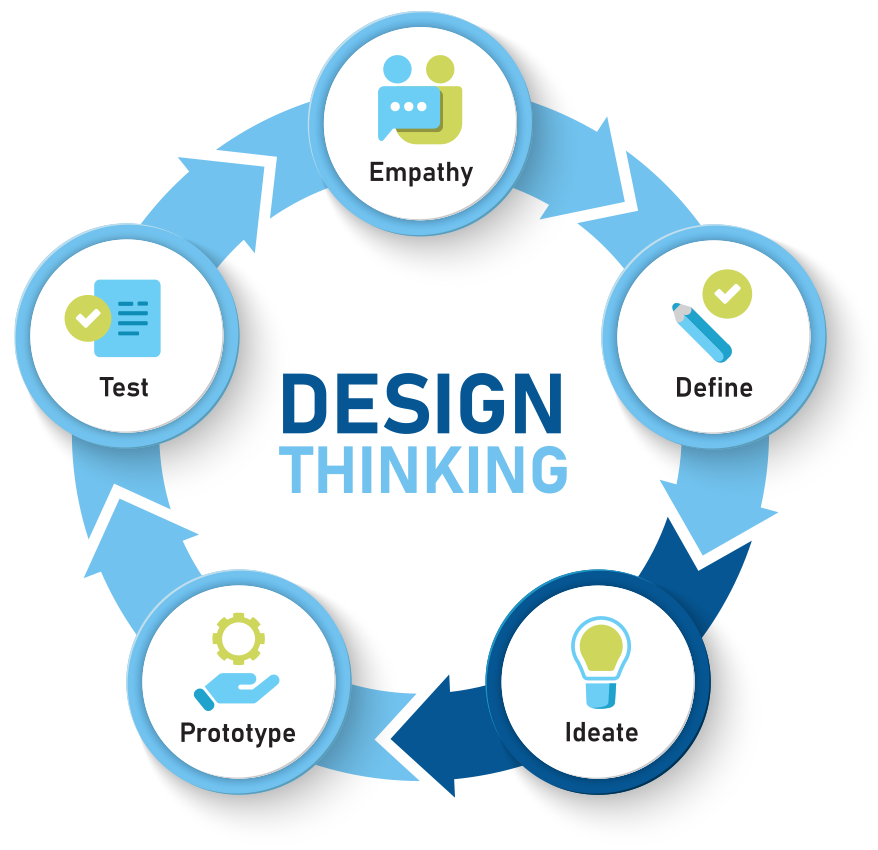IDEATE: Unleashing Creativity in Design Thinking
Posted on March 19, 2024
By Nick Chiechi, President, CS Designworks

In the dynamic world of design thinking, after laying the groundwork with empathy and precisely defining the problem, we embark on the exhilarating phase of Ideation. This stage is where creativity knows no bounds, and the goal is to generate a wide array of innovative solutions. CS Designworks champions this approach, advocating for a brainstorming environment where every idea, no matter how outlandish, is welcomed and considered.
 The Phases of Design Thinking
The Phases of Design Thinking
Empathy: Understanding your Users
Define: Framing the Problem
Ideate: Generating Solutions
Prototype: Bringing Ideas to Life
Test: Refining the Solution
Exploring the Ideate Phase
Ideation is the creative heart of design thinking, encouraging teams to think outside the box and explore a multitude of potential solutions. This phase is characterized by its emphasis on quantity over quality, fostering an environment where creativity flourishes without the constraints of practicality or feasibility.
For business leaders and innovators, ideation is not just a phase; it's a strategic tool. It's about leveraging collective creativity to uncover unexpected solutions that address user needs in novel ways. This approach ensures that the solutions are not only effective but also innovative, setting the stage for a truly transformative impact.
Key Activities in Ideation:
Brainstorming: Engaging in open-ended sessions where every participant is encouraged to voice their ideas, no matter how unconventional.
Mind Mapping: Visually organizing thoughts and exploring the relationships between different ideas.
SCAMPER: Applying a structured approach to think creatively by modifying existing ideas to generate new ones.
These activities propel teams toward a diverse set of solutions, paving the way for the subsequent phases of prototyping and testing. By embracing ideation, businesses can ensure that their solutions are not just practical but also groundbreaking.
Ideation in Action at CS Designworks
At CS Designworks, ideation is more than a phase – it's a philosophy. By fostering a culture of open-mindedness and creativity, they ensure that every project benefits from a broad spectrum of ideas. This inclusive approach to brainstorming allows them to tackle challenges from multiple angles, ensuring that the solutions they develop are both innovative and aligned with user needs.
Conclusion
Ideation stands as a testament to the power of creativity in the design thinking process. By encouraging an unrestricted flow of ideas, businesses can discover solutions that are not only effective but also revolutionary. As demonstrated by CS Designworks, embracing the ideate phase is crucial for developing solutions that truly resonate with users and stand out in the marketplace.
Ideate in Action: A Hypothetical Example for a Commercial Real Estate Company |
|
Continuing the journey with "UrbanSpace Innovators," a commercial real estate firm that has successfully navigated through the Empathy and Define phases of the design thinking process, we now venture into the Ideate phase. This stage is where creativity and innovation take center stage, aiming to generate a broad spectrum of solutions for the well-defined problem at hand. Recap of Define Phase InsightsUrbanSpace Innovators crystallized their insights into a focused problem statement: "Our tenants need office spaces that adapt to their evolving business sizes and styles and promote a sense of community and collaboration, which is currently lacking." This clear definition set the stage for ideation, guiding the team towards solutions that address both the functional and emotional needs of their tenants. |
|
Transition to Ideate Phase Activities in the Ideate Phase Innovative Solutions Emerged Evaluating and Selecting Ideas Impact of the Ideate Phase Wrapping It All UpThe Ideate phase marked a pivotal moment in UrbanSpace Innovators' design thinking journey, transforming a well-defined problem into a springboard for innovation. The ideas generated during this phase laid the groundwork for prototyping and testing, moving one step closer to creating office spaces that not only meet but exceed the expectations of their tenants. This example underscores the transformative power of ideation in developing solutions that are both innovative and deeply aligned with user needs, setting the stage for meaningful change in the commercial real estate sector. |
Next Up: Phase 4 – Prototype
Previous: Phase 2 – Define
Read our Design Thinking Overview
Join Our Blog Community
@CSDesignworks


